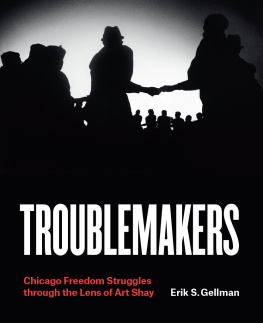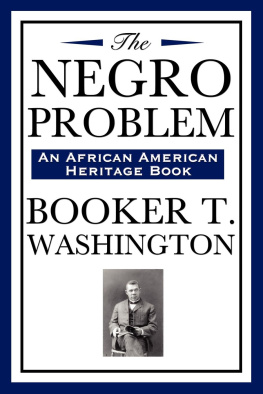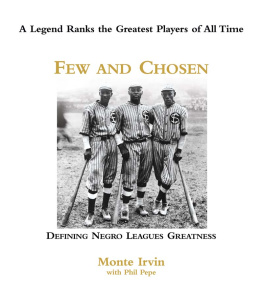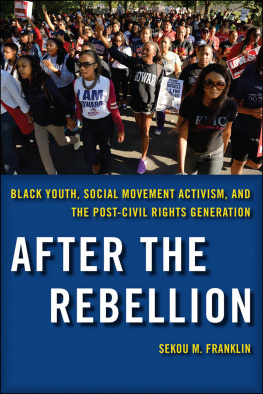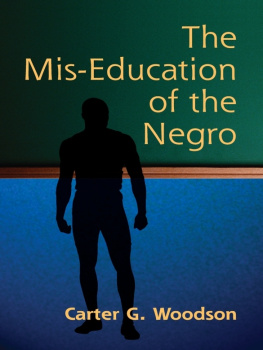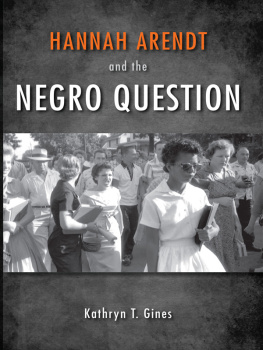DEATH BLOW TO JIM CROW
The John Hope Franklin
Series in African American
History and Culture
WALDO E. MARTIN JR.
AND PATRICIA SULLIVAN,
EDITORS
2012 The University of North Carolina Press All rights reserved Manufactured in the United States of America
Designed by Jacquline Johnson Set in Minion by Tseng Information Systems, Inc.
The paper in this book meets the guidelines for permanence and durability of the Committee on Production Guidelines for Book Longevity of the Council on Library Resources.
The University of North Carolina Press has been a member of the Green Press Initiative since 2003.
Library of Congress Cataloging-in-Publication Data
Gellman, Erik S.
Death blow to Jim Crow : the National Negro Congress and the
rise of militant civil rights / Erik S. Gellman.
p. cm. (The John Hope Franklin series in African American history and culture)
Includes bibliographical references and index.
ISBN 978-0-8078-3531-9 (cloth : alk. paper)
ISBN 978-1-4696-1899-9 (pbk. : alk. paper)
1. National Negro Congress (U.S.)History. 2. Southern Negro
Youth CongressHistory. 3. African AmericansSegregation
History20th century. 4. African AmericansCivil rights
History20th century. 5. Race discriminationUnited
StatesHistory20th century. 6. Civil rights movements
United StatesHistory20th century. 7. African Americans
History18771964. 8. United StatesRace relationsHistory
20th century. I. Title.
E185.61.G278 2012
323.1196'073dc23 2011022145
cloth 16 15 14 13 12 5 4 3 2 1
paper 18 17 16 15 14 5 4 3 2 1
Contents
Illustrations
Will It Help Him?
The world of the NNC in the Chicago area, 19361940
John L. Lewis, Don Harris, and Hank Johnson at PWOC rally, Chicago, July 16, 1939
Edward E. Strong, ca. 1940s
The SNYC and the TSLU in Richmond, 19371940
Richmond tobacco workers on strike against the Export Leaf company, Richmond, 1938
If the Fellow on the Ladder Would Just Get Up and Face Forward
NNC delegation prior to meeting with U.S. Assistant Attorney General O. John Rogge
The NNC picketing the Office of Production Management in Washington, D.C., 1941
Workers at the Glenn A. Martin aircraft factory in Canton, Maryland
NNC leaders meet with labor leader John L. Lewis just before the start of the Third National Negro Congress, April 2628, 1940, Washington, D.C.
Registration desk in the lobby of the U.S. Department of Labor Auditorium, where the Third National Negro Congress convened
A. Philip Randolph and John P. Davis hold the plaque to be awarded to John L. Lewis at the Third National Negro Congress
John L. Lewis speaks on the opening night of the Third National Negro Congress
A. Philip Randolph speaks after John L. Lewis on the opening night of the Third National Negro Congress
Thelma Dale speaks at an NNC event, 1943
Ferdinand Smith and Josh White (with Josh White Jr.) at the Negro Freedom Rally in Madison Square Garden on June 26, 1944
SNYC youth center, Birmingham, Alabama
Right-to-vote march, Birmingham, Alabama, 1946
Samuel Richard Higgins and Esther Cooper Jackson greet Paul Robeson upon his arrival in Columbia, South Carolina, for the SNYCs Southern Youth Legislature, which began on October 17, 1946
Rose Mae Catchings speaks at the Township Auditorium before the sessions of the SNYCs Columbia Youth Legislature, October 1820, 1946
Acknowledgments
This project began through conversations with Hilmar Jensen at Bates College. Hilmars soft-spoken intellect convinced me to study history, and his scholarship on John P. Davis led me to focus on the National Negro Congress. In graduate school, my Northwestern committeeMike Sherry, Martha Biondi, and chair Nancy MacLeanprovided invaluable insights and encouragement. Mike Sherrys so what? question still rings in my ears, and his careful reading of my work helped tremendously. Martha Biondis commitment to struggles for justice and deep knowledge of African American history forced me to rethink how to be a historian, as well as sharpened my analysis. Her support and advice during the revision process have proven essential. Nancy MacLean became everything I had hoped for and more as an intellectual mentor, and her critique of numerous drafts of this work helped immeasurably. In addition, she nudged me to become involved in Chicago history projects, civil rights litigation, and local unions, all of which have informed my academic work. I am proud to continue to seek her mentorship even if she insists on treating me as a colleague.
In addition to my formal committee, a number of professors and fellow students at Northwestern critiqued chapters, outlines, proposals, and other fragments of ideas that went into this book. Thanks especially to Darlene Clark Hine, who has offered me expert advice and comments on all aspects of my scholarship and teaching. I also value the friendly advice and conversation with Lane Fenrich, Jon Glassman, Mike Kramer, Kate Masur, Susan Pearson, and Will Reno. But its really your colleagues who have the opportunity and burden to watch you struggle, thrive, and, on occasion, embarrass yourself. Michael Allen, Justin Behrend, Kate De Luna, Greg Downs, Abram and Kristen Van Engen, Brett Gadsden, Alex Gourse, Neil Kodesh, Jenny Mann, Jana Measells, Gayle Rogers, and David Sellers Smith all made life at Northwestern vibrant and memorable. Each of them had an impact on this book. In addition to these colleagues, a few others went beyond the call. Guy Ortolano made several trips to the Tamiment Library to look at photographs. Ronnie Grinberg read innumerable drafts and provided essential feedback. Debs Cane gave blunt advice, sometimes with a cackle, and had to live with me during some of the rough writing stages. Jarod Roll did so as well, which may explain why he moved across the Atlantic Ocean. Since then, in writing scholarship together, Jarod has become a true collaborator and has read and critiqued every page of this book.
Over the past decade, I have come to understand why Nelson Algren embraced Chicago as this particular patch and defined it as never a lovely so real. My own embrace of Chicago stems from finding excellent sparring partners and colleagues across the city over the years. Leon Fink, Adam Green, and Jim Grossman have provided essential insight into African American and labor history through formal and informal conversations over these years, and I look forward to continuing collaborative work with each of them. The participants in the Newberry Labor History Seminar have never been at a loss for debate, both in session and at the bar afterward. My colleagues at the Chicago Center for Working-Class Studiesespecially Carrie Breitbach, Bob Bruno, Winifred Curran, Jeff Helgeson (now in Texas), Jack Metzgar, and Liesl Orenicpushed me to become more invested in Chicagos neighborhoods and have shown me how to make ideas matter in public forums. I have also found Chicagoans who have committed their livelihoods to struggles for justice and who have flattered me by allowing me to labor with them. Bill Dempsey of UFCW; Elce Redmond of South Austin Coalition; Susan Hurley of Jobs with Justice; James Thindwa of Chicago ACTS; Mike Pitula of LVEJO; Alexis Canalos, Jessica Lawlor, and Carrie Sallgren of UNITE-HERE represent just a few of the many activists and organizers who have taught me more about protest politics than I could ever teach them.
Most of all, however, 430 South Michigan has become my center of gravity in Chicago since 2006. My colleagues and students at Roosevelt University have exceeded my high expectations for a school founded and run on the basis of social justice. Leon Stein and Susan Weininger welcomed me into Roosevelts community. Celeste Chamberlain, Chris Chulos, Sandra Frink, Fabricio Prado, and Margaret Rung have made the Department of History a congenial place. My philosopher neighbors, Stuart Warner and Zarko Minkov, have also made the department a lively intellectual home. I have benefited from the insights and friendship of Jeff Edwards, Stephanie Farmer, Michael Ensdorf, June Lapidus, Mike Maly, and Sam Rosenberg. I look forward to further Drake Center coordination with Al Bennett, Kim Ruffin, Jacqueline Trussell, and Joel Okafur. My faculty mentor, Ellen OBrien, has gone well beyond her job description, mixing sage advice with witty remarks. My colleagues at the Mansfield Institute, especially Heather Dalmage, Nona Burney, Steven Meyers, and Nancy Michaels, have made service work feel not at all like work. Retired professors never seem to leave Roosevelt, which has allowed me to seek out the mentorship of Charles V. Hamilton, Jack Metzgar, and Christopher Reed. Roosevelt also harbors historians outside of the history department, including the always-engaging Brad Hunt and Carl Zimring down the street at the Evelyn T. Stone College of Professional Studies, and I am especially thankful for the support from the historian who also happens to be the Dean of Arts and Sciences, Lynn Weiner.


